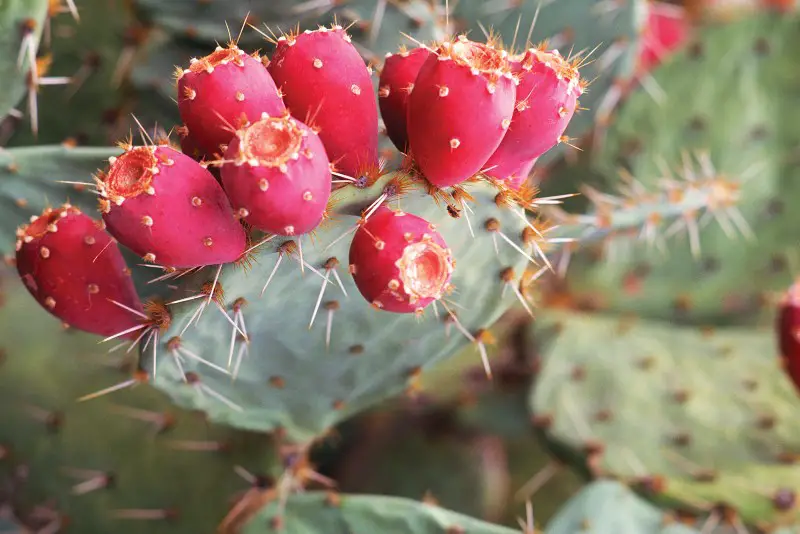The Prickly Pear Cactus (Opuntia humifusa), also known as the Eastern prickly pear or Devil’s tongue, brings the allure of desert plants to a variety of climates, especially those cooler than one might expect for a cactus. While smaller than its desert cousin Opuntia ficus-indica, which can reach heights of over 15 feet, the prickly pear has its own charm with its petite stature, vibrant blooms, and resilience.
This guide will provide everything you need to know about growing, maintaining, and enjoying the Prickly Pear Cactus to ensure it thrives in your garden.
Overview of the Prickly Pear Cactus

- Common Name: Prickly pear, Eastern prickly pear, Devil’s tongue
- Botanical Name: Opuntia humifusa
- Family: Cactaceae
- Plant Type: Cactus
- Mature Size: 6–12 inches in height, 12–18 inches in spread
- Sun Exposure: Full sun
- Soil Type: Sandy, well-draining
- Soil pH: Neutral to acidic
- Bloom Time: Summer
- Flower Color: Yellow, occasionally with red or orange centers
- Hardiness Zones: 4a – 9a (extremely cold hardy)
- Native Area: North America, particularly the eastern United States
Prickly Pear Cactus Care Essentials
Light Requirements
The Prickly Pear Cactus thrives in full sunlight and requires at least eight hours of direct sun per day for optimal growth. However, it can tolerate some partial shade in extremely hot desert climates. Adequate light will not only help the cactus grow taller and fuller but will also promote a higher bloom yield come mid-spring and throughout summer.
Soil Needs
A well-draining, sandy, or gravelly soil mixture is critical for the Prickly Pear. This cactus is not particular about soil pH and can handle a range from neutral to acidic (6.0 to 7.5). If you’re working with heavier soil like clay, amend it with sand to improve drainage, as stagnant water can quickly lead to root rot.
Watering Schedule
Known for its extreme drought tolerance, the Prickly Pear Cactus only requires minimal watering. In most temperate regions, natural rainfall will be sufficient, especially for mature plants. If extra water is needed, plan to water it every two to four weeks, taking care not to overdo it. During the winter, the cactus will naturally “deflate” or shrink as part of its dormancy process—this is completely normal and requires no additional water.
Temperature and Humidity Preferences
The Prickly Pear Cactus thrives in warm, dry conditions but is resilient enough to withstand temperatures as low as 14°F. While it can endure some humidity, excess moisture or misting can be detrimental. Optimal growth and flowering occur when the cactus is kept in a consistently warm and dry environment.
Fertilization
Outdoor plants generally won’t need any fertilizer. However, if growing the cactus indoors or in a container, occasional feeding may benefit the plant. Use a balanced fertilizer (5-10-10) monthly during the growing season if you notice a paler green color or lack of blooms.
Types of Prickly Pear Cactus
Beyond the Eastern prickly pear, several other varieties offer unique characteristics:
- Beavertail (Opuntia basilaris): Recognizable by its pink blooms and preferred in higher elevations up to 8,000 feet.
- Englemann’s Prickly Pear (Opuntia engelmannii): Known for its deep purple fruits and widely spaced spines.
- Mojave Prickly Pear (Opuntia erinacea): Typically found at elevations over 3,500 feet, this variety produces minimal fruit.
- Santa Rita Prickly Pear (Opuntia santa-rita): Distinctive for its blue-gray to purple pads.
Prickly Pear Cactus Maintenance
Pruning
Pruning is optional with the Prickly Pear Cactus. If a particular shape or size is desired, use tongs or a gloved hand to hold a pad securely, and cut it at the base. Pads removed in this manner can be propagated to grow new plants.
Propagating Prickly Pear Cactus
Propagation is typically more successful through pads than seeds, as seeds can take up to three years to develop into a full plant. Select a pad that is at least six months old, allow it to callus over (heal) for about a week, and then plant it upright in sandy soil. After roughly a month, test for new roots by gently tugging. If the cactus resists, it has established roots; if not, give it more time.
Potting and Repotting
This cactus can be grown in containers. Choose a container with ample drainage, and if planting indoors, use cactus-specific soil. Start with a pot just a few inches wider than the cactus pad and upgrade pots as the plant matures, typically every one to two years.
Overwintering
If growing in a pot, bring the Prickly Pear Cactus indoors for winter to protect it from harsh conditions. Outdoor plants can benefit from a thick mulch layer around their base to help insulate them from severe cold.
Common Issues and Pests
While the Prickly Pear Cactus is hardy, it can fall victim to certain problems:
- Overwatering: Too much water can lead to root rot.
- Pests: Insects like scale and mealybugs may infest the cactus. Treat affected areas with rubbing alcohol, neem oil, or a pesticide if infestations are severe.
- Phyllosticta Fungus: This fungal infection, often triggered by humid or wet conditions, results in black lesions on the cactus pads. Although not usually fatal, it is highly contagious, so infected pads should be promptly removed and discarded.
Encouraging Blooms on the Prickly Pear Cactus
Blooms may take several years to appear as the cactus matures. To support blooming, place the cactus in full sunlight and feed it monthly during the growing season with a 5-10-10 fertilizer. Once flowers appear, trim them down to about ten per pad to allow for healthy fruit growth.
Harvesting Prickly Pear Fruit
In addition to its beauty, the Prickly Pear Cactus produces edible fruits known as “tunas.” Although smaller than those of its cousin Opuntia ficus-indica, the fruits of the Eastern prickly pear can be used to make jams, jellies, and pickles. To harvest, ensure you wear gloves and carefully remove the fruit. It’s important to note that the fruits contain small spines, so handle them with care.
Conclusion
The Prickly Pear Cactus is a resilient, low-maintenance plant suitable for a wide range of climates and ideal for gardeners of all experience levels. Its compact size, vibrant yellow blooms, and striking pads make it an appealing addition to gardens, xeriscapes, and even indoor container collections. By following these guidelines for light, soil, water, and seasonal care, you’ll enjoy the unique beauty of the Prickly Pear Cactus year-round.






